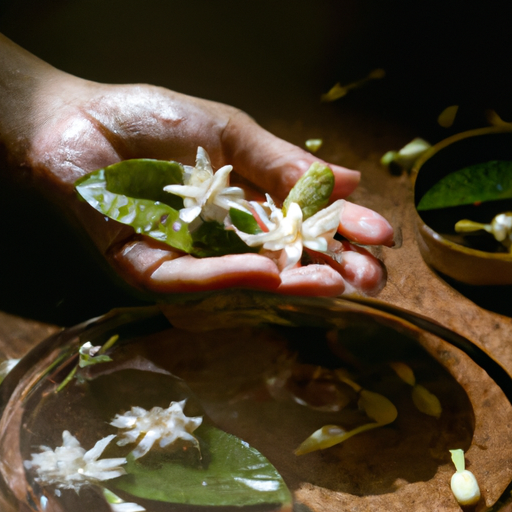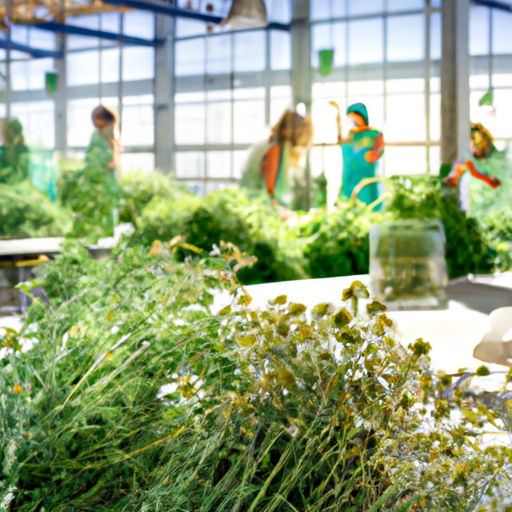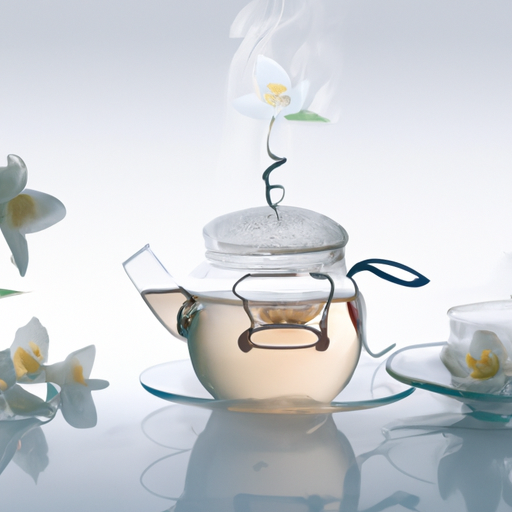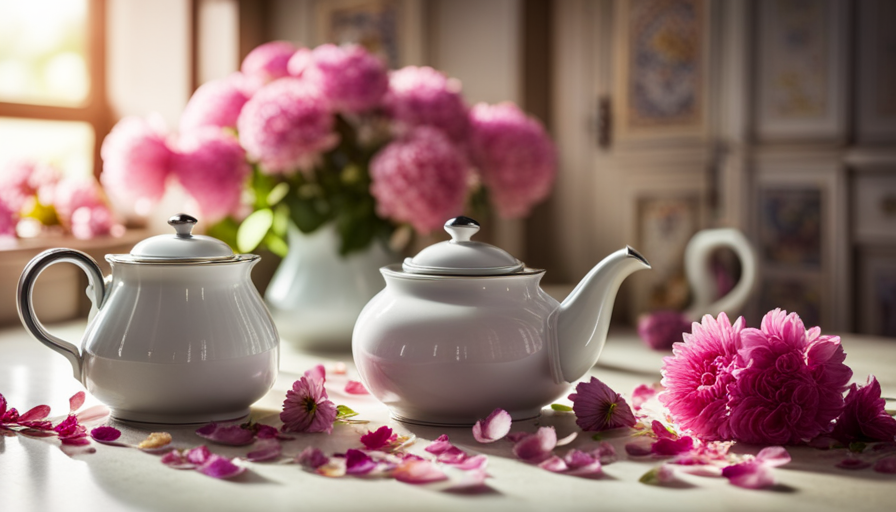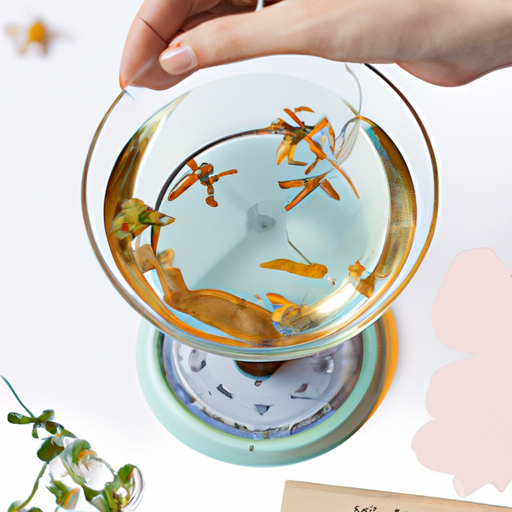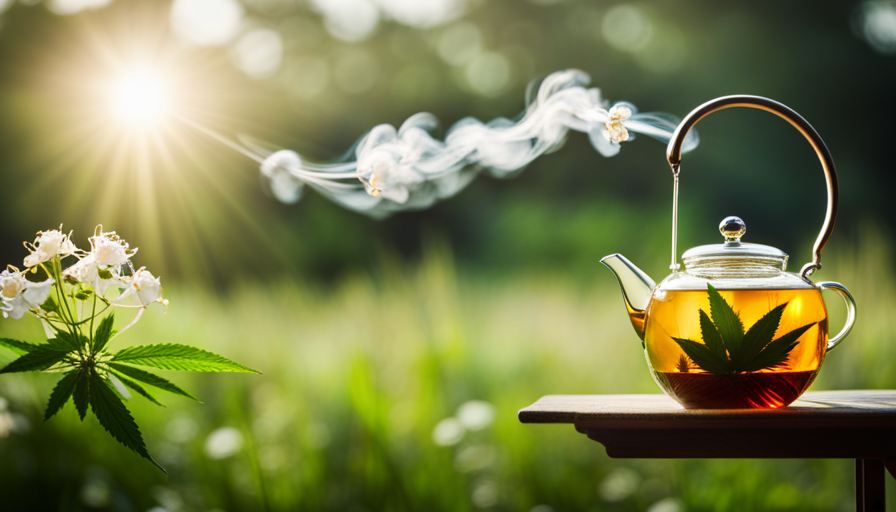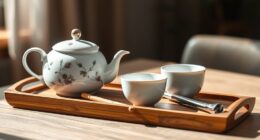As I sit here with a cup of fragrant jasmine tea, I am transported to a world of beauty and tranquility. The delicate aroma of jasmine flowers fills the air, and with each sip, I am reminded of the meticulous process that goes into creating this exquisite beverage.
Jasmine tea is not simply made, it is crafted with care and precision, using only the finest flowers in bloom. Like a skilled artist, the tea makers carefully select the most pristine jasmine flowers, plucked at just the right moment when their fragrance is at its peak. These blossoms are then skillfully blended with tea leaves, allowing their essence to infuse and create a harmonious union of flavors.
The infusion process is where the magic happens. The tea leaves and flowers are carefully layered, allowing the leaves to absorb the intoxicating aroma of the jasmine. This meticulous process results in a tea that is not only visually stunning, with delicate petals dancing in the cup, but also a taste that is sublime and soothing.
Join me on a journey as we delve into the world of jasmine tea, exploring its origins, health benefits, and the countless variations and innovations that have emerged over the years. Let us savor each sip and appreciate the artistry behind this beloved beverage.
Key Takeaways
- Jasmine tea is made by carefully selecting the finest jasmine flowers and blending them with tea leaves to create a harmonious infusion.
- The scenting process is done at night when the flowers are in full bloom, allowing their delicate fragrance to gradually infuse the tea leaves.
- Jasmine-scented leaves are often combined with different tea varieties to create unique flavor profiles, requiring a skilled art of blending.
- Brewing jasmine tea requires a water temperature of around 170°F (77°C) and a steeping time of 3-4 minutes to release the essential oils and create a fragrant brew.
The Origin of Jasmine Tea
So, you’re probably wondering about the origins of that delightful cup of jasmine tea you’re sipping on. Well, let’s take an exciting journey into the origin exploration of this aromatic brew.
Jasmine tea, with its delicate floral scent and soothing taste, has a rich cultural significance that dates back centuries. Originating in China during the Song Dynasty (960-1279 AD), jasmine tea quickly became a cherished beverage among the elite. Chinese tea masters discovered that by blending tea leaves with fresh jasmine flowers, they could infuse the tea with a captivating aroma. This unique process gave birth to jasmine tea as we know it today.
The cultural significance of jasmine tea cannot be understated. In Chinese traditions, it symbolizes purity, elegance, and grace. It is often served during important ceremonies and used to welcome guests as a gesture of hospitality. This fragrant tea has also spread its roots to other countries, such as Japan and India, where it holds similar cultural significance.
Now, let’s move on to the next step in the process: selecting the finest jasmine flowers.
Selecting the Finest Jasmine Flowers
To choose the best blossoms, you’ll want to seek out vibrant petals that exude a delicate, intoxicating aroma. The process of selecting the finest jasmine flowers is crucial in creating a high-quality jasmine tea. These flowers are typically harvested in the early morning when the fragrance is at its peak. The best jasmine flowers come from regions with ideal climate conditions, such as Fujian province in China.
When selecting the flowers, look for ones with unopened buds and tightly wrapped petals. These buds will gradually open during the scenting process, releasing their aromatic oils into the tea leaves. The petals should be a vibrant white or light yellow, indicating their freshness and purity. Avoid flowers with any signs of wilting or browning, as they may have lost their fragrance.
To give you a visual understanding of the process, imagine a table with four rows and two columns. In the left column, there are rows of exquisite jasmine flowers, each one carefully selected for its quality. The right column showcases the different stages of the scenting process, with the flowers gradually releasing their captivating aroma into the tea leaves.
Selecting the finest jasmine flowers sets the foundation for creating a truly exceptional jasmine tea. The next step involves infusing the delicate scent of these flowers into the tea leaves, resulting in a harmonious and fragrant blend.
Scenting the Tea Leaves
For the ultimate aromatic experience, let the tea leaves indulge in the intoxicating embrace of the scented petals, creating a symphony of flavors that’ll transport you to a world of pure bliss.
The scenting process is a crucial step in the creation of jasmine tea, and it requires great skill and attention to detail. Traditional techniques are used to ensure that the tea leaves absorb the delicate fragrance of the jasmine flowers.
First, the tea leaves are carefully plucked and then lightly withered to prepare them for the scenting process. The scenting is typically done at night when the jasmine flowers are in full bloom and release their most captivating aroma. The tea leaves are spread out in thin layers, and fresh jasmine flowers are placed on top of them.
As the night progresses, the flowers naturally release their scent, which is then absorbed by the tea leaves.
This traditional method of scenting the tea leaves allows for a harmonious blend of jasmine and tea flavors. The delicate fragrance of the jasmine flowers infuses the leaves, creating a tea that’s both fragrant and refreshing. The art of blending these two elements is what makes jasmine tea so unique and beloved by tea enthusiasts worldwide.
As we delve into the next section about the art of blending, it’s important to understand the intricate process that goes into creating the perfect cup of jasmine tea.
The Art of Blending
When it comes to the art of blending, I find it fascinating to combine jasmine-scented leaves with different tea varieties. This process allows me to create unique flavor profiles that are both delightful and unexpected.
The possibilities are endless, as I experiment with different combinations and ratios to achieve the perfect balance of aroma and taste.
Combining jasmine-scented leaves with different tea varieties
Jasmine-scented leaves are often combined with various tea varieties, creating a delightful floral infusion that captivates the senses. This art of tea blending involves skillfully evaluating the aroma of different teas and selecting the perfect combination that complements the delicate jasmine fragrance.
Here are four key aspects of this process:
-
Tea blending: The process starts with selecting high-quality tea leaves that can withstand the floral infusion. Different tea varieties, such as green tea, white tea, or oolong tea, are carefully chosen based on their flavor profiles.
-
Aroma evaluation: The jasmine-scented leaves are then added to the selected tea leaves, allowing their fragrant oils to infuse and enhance the overall aroma. The goal is to achieve a harmonious balance between the floral notes and the base tea.
-
Time and temperature: The length of time and the temperature at which the leaves are steeped play a vital role in determining the final flavor. These factors are meticulously adjusted to create the perfect infusion.
-
Artistic flair: Skilled artisans often add their own creative touch to the process, experimenting with different ratios and techniques to create unique flavor profiles that appeal to a wide range of palates.
By combining jasmine-scented leaves with different tea varieties, a symphony of flavors is created, offering a delightful experience for tea enthusiasts.
Creating unique flavor profiles
After combining jasmine-scented leaves with different tea varieties, it’s time to embark on the exciting journey of creating unique flavor profiles.
This is where the true artistry of jasmine tea making comes into play. As a tea enthusiast, I’ve spent countless hours experimenting with different tea blends to discover the perfect combination that results in a harmonious marriage of flavors. By carefully selecting the base tea, whether it’s green, black, or white, and then introducing the fragrant jasmine petals, I’m able to create a delightful symphony of taste and aroma.
Each tea blend offers a distinct personality, and the jasmine infusion adds a floral note that elevates the overall experience. As I continue to delve into the world of jasmine tea, I’m constantly inspired to push boundaries and discover new and exciting flavor combinations.
Now, let’s explore the infusion process and unlock the secrets behind its magic.
The Infusion Process
To make jasmine tea, you carefully pour hot water over a handful of jasmine flowers and watch as the delicate petals dance and infuse the water with their intoxicating fragrance. This infusion process is a delicate art that requires precise timing and technique to achieve the perfect balance of flavor and aroma.
Here’s how it’s done:
-
Water temperature: The water should be heated to around 170°F (77°C) to ensure the delicate jasmine flowers aren’t scorched, which could result in a bitter taste.
-
Steeping time: The flowers are steeped in hot water for about 3-4 minutes. This allows the petals to release their essential oils, creating a fragrant and flavorful brew.
-
Straining: After the steeping time is complete, the jasmine flowers are removed from the water using a strainer or tea infuser. This ensures that only the essence of the flowers remains in the tea.
-
Health benefits: Jasmine tea isn’t only a delight for the senses but also offers numerous health benefits. It’s rich in antioxidants, which can help protect the body against free radicals and reduce the risk of chronic diseases.
With the infusion process complete, the next step is quality control and tasting, where experts evaluate the tea’s flavor, aroma, and overall quality.
Quality Control and Tasting
When it comes to quality control and tasting in the production of jasmine tea, there are two key points that I want to discuss: evaluating aroma and flavor, and ensuring consistent quality.
In order to maintain the high standards of jasmine tea, it’s important to carefully assess the aroma and flavor profiles of each batch. This involves experienced tasters who’re able to detect any variations or deviations from the desired characteristics.
Additionally, consistent quality is crucial in providing consumers with a reliable and enjoyable jasmine tea experience. Through rigorous testing and monitoring, producers can ensure that each cup of jasmine tea meets the expected standards of excellence.
Evaluating aroma and flavor
Indulge in the delightful aroma and exquisite flavor of jasmine tea, a true sensory experience. When evaluating the aroma of jasmine tea, there are three key factors to consider:
- Intensity: A high-quality jasmine tea should have a strong and captivating aroma that instantly transports you to a blooming jasmine garden.
- Floral Notes: The aroma should be dominated by the sweet and fragrant scent of jasmine flowers, with subtle hints of other floral undertones.
- Freshness: The aroma should be fresh and vibrant, indicating that the tea leaves have been properly stored and processed.
As for flavor, jasmine tea should offer a harmonious balance between the floral sweetness of jasmine and the delicate bitterness of the tea leaves. The flavor should be smooth and refreshing, leaving a lingering floral aftertaste.
Evaluating both aroma and flavor allows us to ensure the consistent quality of our jasmine tea, maintaining the enchanting experience for every sip.
Ensuring consistent quality
Experience the assurance of unwavering quality with each sip, as you savor the consistent excellence of our meticulously crafted blend. Ensuring consistent quality is of utmost importance in the production of jasmine tea.
From the careful selection of tea leaves to the precise timing of the jasmine infusion process, every step is meticulously executed to maintain the highest standards. We’ve implemented stringent quality control measures to guarantee that every batch of tea delivers the same exceptional taste and aroma that our customers have come to expect.
Our commitment to consistent quality extends beyond taste and aroma, as we also prioritize the health benefits of jasmine tea. Transitioning into the next section on the health benefits of jasmine tea, discover how our tea not only delights the senses but also nourishes the body.
Health Benefits of Jasmine Tea
One of the most sought-after benefits of jasmine tea is its ability to promote relaxation and reduce stress levels. This fragrant tea is not only a treat for the senses, but it also offers numerous health benefits. Here are three reasons why jasmine tea is a great choice for those looking to unwind and improve their well-being:
-
Calming properties: The delicate aroma of jasmine flowers has a soothing effect on the mind and body. Jasmine tea contains compounds that can help reduce anxiety and promote a sense of calmness. Sipping on a cup of jasmine tea after a long day can help you unwind and relax.
-
Stress reduction: The act of preparing and savoring jasmine tea can be a meditative experience. Taking a few moments to focus on the ritual of brewing and enjoying the tea can help alleviate stress and promote mindfulness. The combination of the tea’s aroma and the act of sipping can create a peaceful atmosphere.
-
Improved sleep: Jasmine tea is often recommended for those struggling with sleep issues. The tea’s calming properties can help relax the body and mind, making it easier to fall asleep and enjoy a restful night’s sleep.
As you can see, jasmine tea offers a multitude of health benefits, including relaxation and stress reduction. Now let’s explore the next section about serving and enjoying jasmine tea.
Serving and Enjoying Jasmine Tea
Get ready to savor the delightful flavors of this fragrant brew while discovering the best ways to serve and enjoy it.
When it comes to serving jasmine tea, there are a few techniques that can enhance your experience. Firstly, it’s important to use the right water temperature. Jasmine tea is delicate, so boiling water can scorch the leaves and result in a bitter taste. Instead, opt for water that’s around 175°F (80°C) to ensure the perfect infusion.
Secondly, consider using a glass teapot or cup to showcase the beautiful blooming flowers and vibrant color of the tea. This not only adds visual appeal but also allows you to observe the tea leaves unfurling and releasing their aroma.
Lastly, to fully appreciate the health benefits of jasmine tea, it’s recommended to drink it without any sweeteners or additives. This allows you to experience the natural floral notes and subtle sweetness of the tea.
Now that you’ve learned about serving techniques and the health benefits of jasmine tea, let’s explore the exciting world of variations and innovations in jasmine tea preparation.
Variations and Innovations
When it comes to serving and enjoying jasmine tea, there are various variations and innovations that can elevate your experience. Here are four ways to enjoy this delightful beverage:
-
Iced Jasmine Tea: For a refreshing twist, try brewing jasmine tea and letting it cool before pouring it over ice. Add a squeeze of lemon or a sprig of mint for an extra burst of flavor.
-
Jasmine Green Tea Latte: Combine the floral notes of jasmine tea with the creaminess of a latte. Steep jasmine tea in hot milk, sweeten to taste, and top with frothed milk for a luxurious treat.
-
Jasmine Tea Mocktail: Mix jasmine tea with your favorite fruit juices, such as pineapple or peach, and garnish with a slice of citrus or a sprig of fresh herbs. This alcohol-free option is perfect for parties or a relaxing evening at home.
-
Jasmine Tea Infused Desserts: Incorporate the delicate flavor of jasmine tea into your favorite desserts. From jasmine-infused cakes and cookies to jasmine tea ice cream, the possibilities are endless.
By exploring these variations and innovations, you can truly immerse yourself in the world of jasmine tea. So, let’s delve deeper into the wonders this aromatic tea has to offer.
Exploring the World of Jasmine Tea
As you sip on this fragrant elixir, a symphony of delicate petals dances upon your palate, transporting you to a world of unparalleled bliss. Jasmine tea has a rich and fascinating history that spans centuries, originating in China during the Song Dynasty. It was originally created by blending jasmine flowers with green tea leaves, resulting in a harmonious infusion of flavors. Today, variations of jasmine tea can be found across the globe, with different countries adding their own unique twists to this beloved beverage.
Let’s dive into the world of jasmine tea and explore its intricate flavors and health benefits. In the table below, you will find a visual representation of some key aspects:
| Aspect | Flavor Profile | Health Benefits |
|---|---|---|
| Green Tea Base | Light, vegetal | Antioxidant properties |
| White Tea Base | Subtle, sweet | Aids in relaxation |
| Black Tea Base | Bold, robust | Boosts metabolism |
| Oolong Tea Base | Floral, fruity | Enhances digestion |
Jasmine tea not only delights the senses but also offers numerous health benefits. The combination of tea and jasmine flowers provides a rich source of antioxidants, which help fight free radicals and promote overall well-being. Additionally, the calming properties of jasmine tea can aid in stress reduction and relaxation. This aromatic elixir has also been linked to improved digestion and increased metabolism, making it a popular choice among those seeking a healthy lifestyle.
So, as you continue your exploration of jasmine tea, allow yourself to be captivated by its history and indulge in its healthful qualities.
Frequently Asked Questions
How long does it take for jasmine tea to be fully scented with jasmine flowers?
The scenting period for jasmine tea typically takes several hours to a couple of days, depending on the desired intensity of jasmine aroma. During this time, the tea leaves are carefully layered with fresh jasmine flowers, allowing the natural fragrance to infuse into the tea.
This traditional method ensures that the tea absorbs the floral essence, resulting in a delightful and aromatic brew that’s enjoyed by tea enthusiasts worldwide.
Can jasmine tea be made with other types of tea leaves besides green tea?
Jasmine tea can indeed be made with other types of tea leaves besides green tea. While green tea is the most commonly used base for jasmine tea, there are alternatives like white tea, oolong tea, and black tea that can also be used. Each type of tea leaf brings its own unique flavor and characteristics to the jasmine tea, resulting in a delightful variety of options for tea enthusiasts to explore.
Are there any specific health conditions for which jasmine tea is not recommended?
There are specific health conditions for which jasmine tea is not recommended. It’s advised to avoid jasmine tea if you have a caffeine sensitivity or if you’re pregnant or breastfeeding. Due to its caffeine content, it can also interfere with certain medications or exacerbate conditions like anxiety or insomnia. It’s important to consult with a healthcare professional for personalized recommendations regarding the consumption of jasmine tea.
What is the best way to store jasmine tea to maintain its freshness?
Storing jasmine tea properly is crucial to maintain its freshness and flavor. The best way to store it is in an airtight container, away from light, heat, and moisture. This helps preserve the delicate floral aroma and taste.
Imagine a little jar, tightly sealed, protecting the tea’s essence like a treasure chest. By following these guidelines, you can extend the lifespan of your jasmine tea and savor its delightful flavors for a longer period.
Can the scenting process be done with artificial jasmine flavor instead of real jasmine flowers?
The scenting process with artificial jasmine flavor can be done, but it’s not recommended. Real jasmine flowers are preferred in tea making due to their numerous benefits. The natural aroma and flavor of real jasmine flowers infuse the tea leaves, creating a delicate and refreshing taste.
Additionally, real jasmine flowers contain natural antioxidants and essential oils that contribute to the overall health benefits of jasmine tea. Using real jasmine flowers enhances the authenticity and quality of the tea.
Conclusion
In conclusion, the process of making jasmine tea is truly a labor of love. From carefully selecting the finest jasmine flowers to skillfully scenting the tea leaves, each step is meticulously executed to create a fragrant and flavorful brew.
Like a delicate dance, the art of blending and the infusion process come together to produce a tea that’s both soothing and invigorating.
So why not immerse yourself in the world of jasmine tea and let its enchanting aroma transport you to a place of tranquility and bliss?

